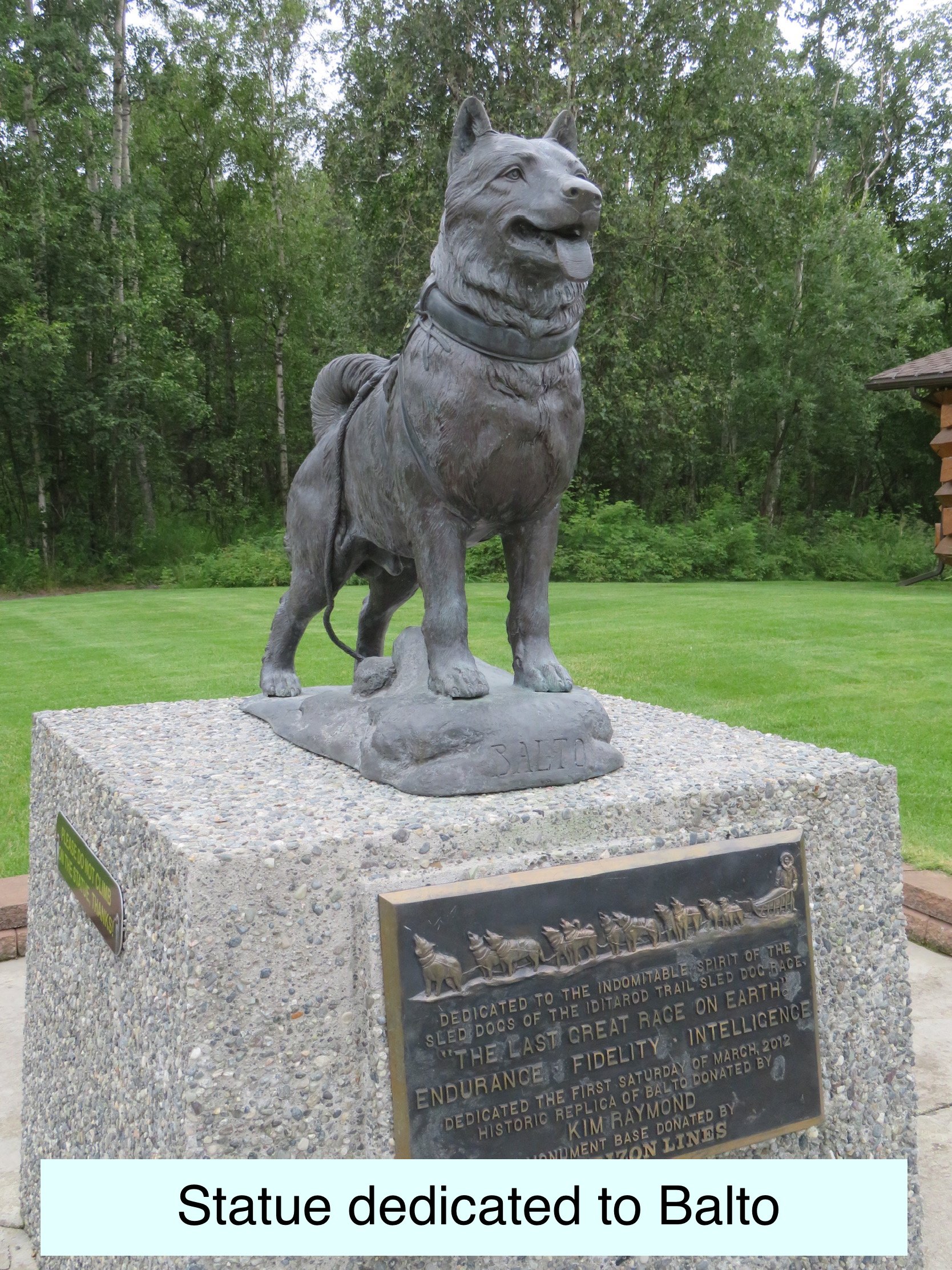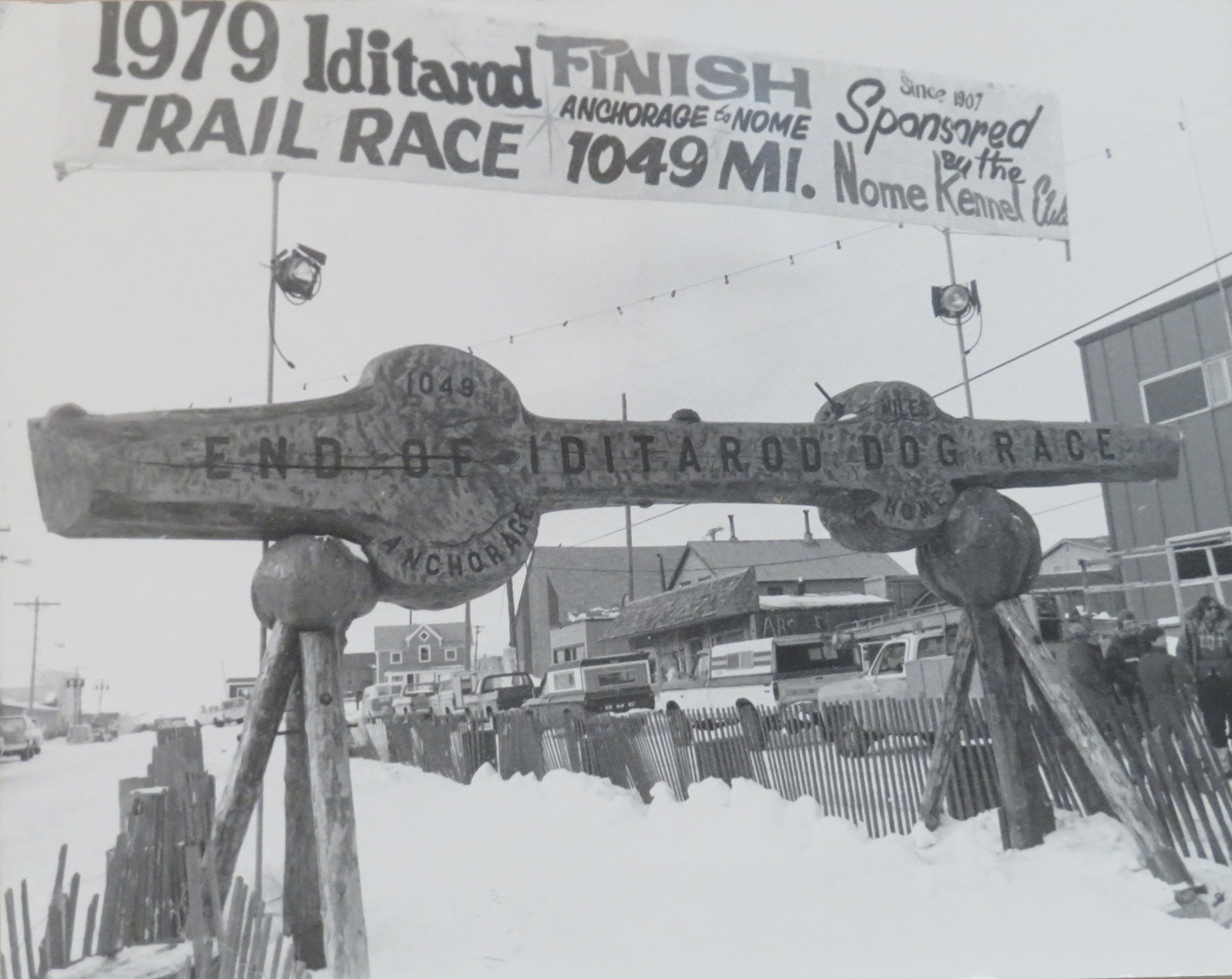Blue View - The Iditarod Dog Sled Race
/
In our travels in and around Alaska, we kept running into historical references to the Iditarod Trail. We saw a marker in Seward identifying the start of the Iditarod Trail and at several spots along roadways, we’ve seen turnouts marking access to the trail. Then in Anchorage, we walked by a placard marking the starting line of the Iditarod Race.
I thought I knew what the race was about. Back in the early 1900s (or was it the late 1800s?), there was an outbreak of some type of disease (smallpox? typhoid? anthrax?) in Nome, Alaska, and the townsfolk were dying by the hundreds. They desperately needed the vaccine (antidote?), and the only way to get it there, being as it was the dead of winter, was by dogsled. Some heroic dogsledders volunteered to take the cure to Nome from Anchorage (or was it Fairbanks? Seward? Iditarod?) and, overcoming some serious obstacles like -40 degree weather, glacier crevasses, etc. managed to get the cure to Nome… in no small part because of the stamina, courage and leadership of the lead dog Balto, thus saving the town. Ever since then, there’s been an annual dogsled race following the same route to commemorate the lifesaving heroics of the team and musher. Sound about right?
It wasn’t until I did a little research that I found out how misinformed I was. You may already know the real story of the Iditarod Race, but if not, stick with me.
Serum to Nome
In the winter of 1925, a small outbreak of diphtheria occurred Nome, and there wasn’t enough serum to inoculate the entire town. They wired for help, and plans were made to fly the serum to Nome from Fairbanks. Unfortunately, prolonged bad weather grounded the flight, so instead, the serum was sent by train to Nanana, where a relay of dogsleds took it down the Yukon River, then along the Iditarod Trail to Nome. It took the relay of twenty mushers just over five days to make the 674 mile trip.
That’s a great story, but has nothing to do with the Iditarod Race, which, for the most part, follows an entirely different path. There is, in fact, a “Serum Dog Sled Race” that follows the route of the serum delivery to Nome, but, except for the last two hundred or so miles, the Iditarod Race and Serum Race follow different paths.
BTW, the lead dog for the last leg of the famous serum run was Balto, who was commemorated with statues and featured in at least three movies. It was actually the dog Togo, however, that led the sled teams most of the way and through all the difficult sections, but since Balto led the last leg into Nome, he got all the credit and fame while Togo got short shrift.
The Iditarod Trail
The Iditarod Race follows a different route, the Iditarod Trail, which was an important part of Alaska’s history. For thousands of years, parts of the present day route were used to connect the coastal people with the people in the interior for trading purposes. Later, during the fur trading period, it served as a supply route for many of the trading posts established by the Russians, French and Americans. In 1898, gold was discovered near present day Nome by three inexperienced prospectors - who became known as the “three lucky Swedes”. Nome became an instant city, and when more gold was found along the shore of the Bering Sea, the stampede was on. By 1900, an estimated 25,000 people arrived by steamboat, chasing the dream of being able to dig gold right on the beach. Soon, other strikes were made in the northwest and central parts of the state.
The last major gold rush occurred in the Iditarod and Ruby areas in the interior of Alaska between 1910 and 1912. Another 10,000 prospectors made their way there to find their fortunes.
All the new mining camps and settlements needed mail, supplies and provisions. During the summer months, these could be transported from the coast using overland trails or via the many rivers that flowed from the interior to the Bering Sea. In winter, however, when the Bering Sea iced over, the nearest navigable port was way down south in ice-free Seward. In 1908, William Goodman and a crew of three were tasked with laying out a winter route from the port of Seward, along the Cook Inlet, through the boom town of Iditarod, and onward to Nome. Between January and April of that year, they blazed the entire 800-mile route, which came to be known as the Iditarod Trail.
Dog sleds were the only way to travel the Iditarod Trail in winter. Mushers and their teams raced along the route delivering everything from eggs to mail to the far-flung camps. Roadhouses were established all along the route to shelter them and the occasional passengers. Not surprisingly, a number of colorful characters were drawn to the area, and entire books have been written about them.
One legendary musher was Bob Griffis and his annual gold train. In November, 1910, the Miners and Merchants Bank hired him to carry a shipment of gold from Iditarod to Seward. He lashed $250,000 of gold to his sled and headed south. The 63 year old Griffis figured the winter cold would deter any robbers, and sure enough, 37 days later he pulled into Seward. He repeated this at least once a year until WWI, carrying as much as a million dollars worth of gold per trip, and was never robbed.
After WWI, the trail usage began to decline. Much of the gold was depleted, and mines began to close. The once thriving town of Iditarod was abandoned, becoming a ghost town. Planes began delivering supplies and mail, reducing the need for dog sleds. The final delivery of supplies by sled dogs was made in 1963. By then, the dogsled was totally replaced by snow machines and airplanes.
Because it played such a major role in Alaska’s history, Congress established the Iditarod as a National Historic Trail in 1978.
The Iditarod Trail Dog Sled Race
Nicknamed “The Last Great Race on Earth”, the Iditarod Sled Dog Race was the dream of Joe Remington who thought it was important to preserve the culture of sled dogs and their use in Alaska. Through his efforts, the first race was run in 1973, and has been held every year since. The route varies each year, but is always around 1000 miles long, and travels over mountain ranges, through long stretches of flat tundra, to the western Alaskan coast and finally to the town of Nome.
The ceremonial start is in Anchorage on the first Saturday of March. After a short run, the dogs and sleds are transported to Willow, 72 miles north of Anchorage, for the official start a day later. (There often isn’t enough snow anymore to run the race from Anchorage.)
There are 26 or 27 checkpoints, depending on the route, where mushers have to check-in. At each checkpoint, they can re-provision, rest, and change sleds if necessary. In addition,at each stop, the dogs are all checked by a vet to ensure that they remain healthy and are not injured. During the race, to prevent overworking the dogs, each musher is required to take at least one 24 hour and two 8 hour rest breaks.
Last year, the 2023 race had 33 teams, the lowest number in many years. The decline in numbers was attributed to financial issues due to the pandemic and the higher cost to participate due to inflation. Of the 33 teams, 29 completed the race.
In 1985, Libby Riddles became the first woman to win the Iditarod, followed by Susan Butcher, who won in 1986, 1987, 1988 and 1990. Her victories led to one of our favorite tee shirts - “Alaska - Where Men are Men and Women Win the Iditarod”.
The prize money is determined after the race, and depends in part on the number of entries and the number of finishers. First prize is usually more than $50,000, and those that place in the top twenty usually receive between $10,000 and $20,000. All finishers receive at least $1000.
On the other hand, the cost to participate in the race is non-trivial. The entry fee in 2022 was $4000, but that’s only a small part of the cost that a musher must spend. Food for both the musher and the dogs has to be delivered to each checkpoint at a typical cost of $120 per checkpoint. The mandatory vet checks cost several hundred dollars. The dogs, gear and musher all have to be flown back from Nome, where the sky-kennels alone cost $75 per dog. There’s local expenses for food and lodging at both ends. Then there’s the cost of all the gear that must be provided for the dogs, sled and musher - everything from arctic clothing, to sled runners, to dog booties.
Anna and Kristy Berington, twins who between them have run the Iditarod at least twenty times, estimate the total cost to enter and run the race is more than $20,000. Some of the gear, like the arctic clothing can be used for more than one race, of course, (assuming one actually wanted to do more than one race), but most of that money must be spent with each race.
Then there’s the cost to buy, train and support 12-14 sled dogs. One Iditarod musher estimated that it would cost around $32,000 to replace his 14 dogs. Anna and Kristi budget $2,000 per dog per year for food, shelter, vet checks, vaccinations, and other miscellaneous items. They have, at last count, over 40 dogs! I don’t think that includes the cost of a place big enough to house, exercise and train 14-40 dogs, or the vehicle to transport them all.
All in all, not a cheap hobby, and all so that you can enjoy a brisk outing in -40 degree weather, enduring snow, sleet and ice storms, sleep deprivation and numbing fatigue for 8-14 days. For me, it would be pushing the limits of my endurance just standing in the cold watching the start of the race. I think we’ll stick to watching the highlights on ESPN.
See you next week…










